
The Presidents' Conference Committee (PCC) is a streetcar design that was first built in the United States in the 1930s. The design proved successful domestically, and after World War II it was licensed for use elsewhere in the world where PCC based cars were made. The PCC car has proved to be a long-lasting icon of streetcar design, and many remain in service around the world.

The Halton County Radial Railway is a working museum of electric streetcars, other railway vehicles, buses and trolleybuses. It is operated by the Ontario Electric Railway Historical Association (OERHA). It is focused primarily on the history of the Toronto Transit Commission (TTC) and its predecessor, the Toronto Transportation Commission, Its collection includes PCC, Peter Witt, CLRV and ALRV, and earlier cars from the Toronto streetcar system as well as G-series and M-series Toronto subway cars.
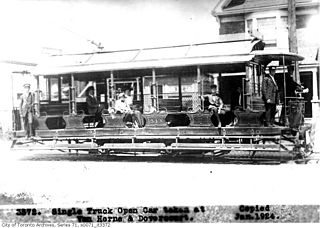
The Toronto Railway Company (TRC) was the operator of the streetcar system in Toronto between 1891 and 1921. It electrified the horsecar system it inherited from the Toronto Street Railway, the previous operator of streetcar service in Toronto. The TRC was also a manufacturer of streetcars and rail work vehicles, a few of which were built for other streetcar and radial operators.
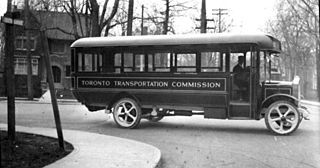
Toronto Transportation Commission (TTC) was the public transit operator in Toronto, Ontario, Canada, beginning in 1921. It operated buses, streetcars and the island ferries. The system was renamed the Toronto Transit Commission (TTC) in 1954.

The Davisville Subway Yard is a rail yard on the Toronto Transit Commission's Yonge subway line. The train maintenance and storage building is referred to as the Davisville Carhouse.

The Toronto streetcar system is a network of eleven streetcar routes in Toronto, Ontario, Canada, operated by the Toronto Transit Commission (TTC). It is the third busiest light-rail system in North America. The network is concentrated primarily in Downtown Toronto and in proximity to the city's waterfront. Much of the streetcar route network dates from the 19th century. Three streetcar routes operate in their own right-of-way, one in a partial right-of-way, and six operate on street trackage shared with vehicular traffic with streetcars stopping on demand at frequent stops like buses. Since 2019, the network has used low-floor streetcars, making it fully accessible.

509 Harbourfront is a Toronto streetcar route in Ontario, Canada, operated by the Toronto Transit Commission and connecting Union Station with Exhibition Loop.
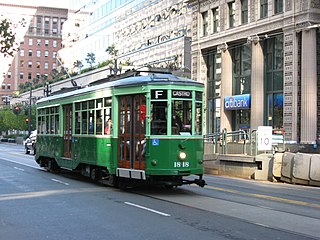
The Peter Witt streetcar was introduced by Cleveland Railway commissioner Peter Witt (1869–1948) who led the transit agency from 1911 to 1915 and designed a model of streetcar known by his name that was used in many North American cities, most notably in Toronto and Cleveland.

The 512 St. Clair is an east–west streetcar route in Toronto, Ontario, Canada, operated by the Toronto Transit Commission (TTC). It operates on St. Clair Avenue between St. Clair station on the Line 1 Yonge–University subway and Gunns Road, just west of Keele Street.

The Canadian Light Rail Vehicle (CLRV) and Articulated Light Rail Vehicle (ALRV) were types of streetcars used by the Toronto Transit Commission (TTC) from the late 1970s until the late 2010s. They were built following the TTC's decision to retain streetcar services in the 1970s, replacing the existing PCC streetcar fleet.

The Presidents' Conference Committee Car was a streetcar used by the Toronto Transportation Commission and the Toronto Transit Commission. The PCC streetcar was designed by the Presidents' Conference Committee, a group of transit operators in the United States and Canada.

506 Carlton is a Toronto streetcar route run by the Toronto Transit Commission in Ontario, Canada. It runs from Main Street station on subway Line 2 Bloor–Danforth along Gerrard, Carlton and College Streets to High Park. Despite the route's name, less than 10 percent of its length actually uses Carlton Street.
Accessibility for people with disabilities on the Toronto Transit Commission (TTC) system is incomplete but improving. Most of the Toronto subway system was built before wheelchair access was a requirement under the Ontarians with Disabilities Act (ODA). However, all subway stations built since 1996 are equipped with elevators, and elevators have been installed in 45 stations built before 1996. Over three-quarters of Toronto's subway stations are accessible. The original plan was to make all stations accessible by 2025; however, a few stations might not be accessible until 2026.

The Flexity Outlook is the latest model of streetcar in the rolling stock of the Toronto streetcar system owned by the Toronto Transit Commission (TTC). Based on the Bombardier Flexity, they were first ordered in 2009 and were built by Bombardier Transportation in Thunder Bay and Kingston, Ontario, with specific modifications for Toronto, such as unidirectional operation and the ability to operate on the unique broad Toronto gauge.
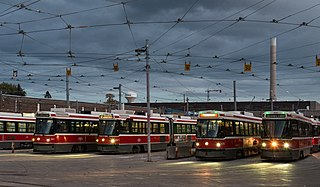
The Russell Carhouse, located at Queen Street East and Connaught Avenue just east of Greenwood Avenue in Toronto, is the Toronto Transit Commission's second oldest carhouse.
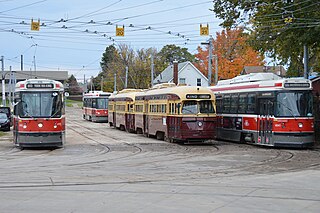
In 1921, the Toronto Transportation Commission (TTC) was created to integrate and operate the Toronto streetcar system. The system has had numerous different rolling stock throughout its history.

In the 1970s and 1980s, three Toronto Peter Witt cars, specifically 2766, 2424 and 2894, provided tour tram services in downtown Toronto. Car 2766 was owned by the TTC while the other two were owned by the Ontario Electric Railway Historical Association (OERHA) and were on loan to the TTC for special runs on the Toronto streetcar system.

The Toronto Transit Commission operated the Bloor streetcar line along Bloor Street and Danforth Avenue, extending at its longest from Jane Street in the west end of the city to Luttrell Avenue in the east. Both Luttrell and Jane loops at the termini were transfer points between streetcars and suburban bus routes. The line was abandoned in 1966 with the opening of the Bloor-Danforth subway line, except for two stubs of the line abandoned in 1968.
Beginning operation in 1861, the Yonge streetcar line was the first streetcar line in Toronto and the first in Canada. It started off as a horsecar line and closed in 1954 operating two-unit trains of Peter Witt motors pulling a trailer. Under the Toronto Transportation Commission, the Yonge line was the busiest and most congested streetcar line in the city leading to its replacement in 1954 by the Yonge Subway line, also Toronto's first and the first in Canada.

The St. Clair Carhouse was a streetcar facility in Toronto, Ontario, Canada. It was located south of St. Clair Avenue on a parcel of land bounded by Wychwood Avenue on the east, Benson Avenue on its north side and Christie Street on the west side. It was opened by the Toronto Civic Railways in 1913, taken over by the Toronto Transportation Commission in 1921 and closed by its successor, the Toronto Transit Commission, in 1998. The carhouse was subsequently transformed into a community centre called the Wychwood Barns.




















